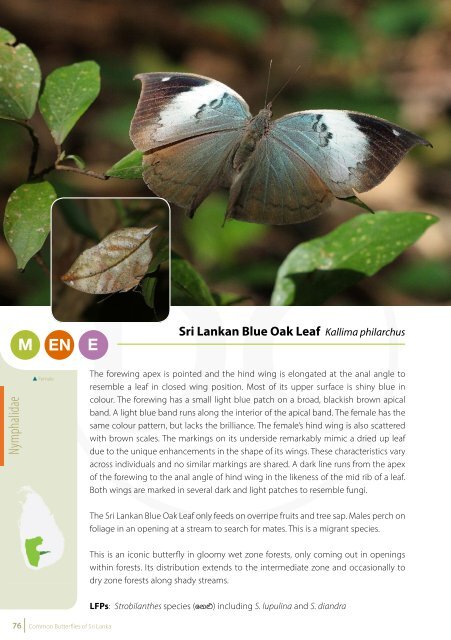Common Butterflies of Sri Lanka
Common Butterflies of Sri Lanka
Common Butterflies of Sri Lanka
Create successful ePaper yourself
Turn your PDF publications into a flip-book with our unique Google optimized e-Paper software.
M<br />
EN<br />
E<br />
<strong>Sri</strong> <strong>Lanka</strong>n Blue Oak Leaf Kallima philarchus<br />
<strong>Common</strong> Sailor Neptis hylas<br />
S<br />
LC<br />
Nymphalidae<br />
Female<br />
The forewing apex is pointed and the hind wing is elongated at the anal angle to<br />
resemble a leaf in closed wing position. Most <strong>of</strong> its upper surface is shiny blue in<br />
colour. The forewing has a small light blue patch on a broad, blackish brown apical<br />
band. A light blue band runs along the interior <strong>of</strong> the apical band. The female has the<br />
same colour pattern, but lacks the brilliance. The female’s hind wing is also scattered<br />
with brown scales. The markings on its underside remarkably mimic a dried up leaf<br />
due to the unique enhancements in the shape <strong>of</strong> its wings. These characteristics vary<br />
across individuals and no similar markings are shared. A dark line runs from the apex<br />
<strong>of</strong> the forewing to the anal angle <strong>of</strong> hind wing in the likeness <strong>of</strong> the mid rib <strong>of</strong> a leaf.<br />
Both wings are marked in several dark and light patches to resemble fungi.<br />
The <strong>Sri</strong> <strong>Lanka</strong>n Blue Oak Leaf only feeds on overripe fruits and tree sap. Males perch on<br />
foliage in an opening at a stream to search for mates. This is a migrant species.<br />
The sexes look similar but the female is quite large. The upper side is blackish brown.<br />
A white streak commencing from the base <strong>of</strong> the forewing is followed by two white<br />
spots which form a band. A basal line on the hind wing together with patches on the<br />
forewing form a second parallel band. Rectangular patches on the hind wing make up<br />
a third parallel band. The marginal and sub-marginal white bands are fairly indistinct.<br />
The background <strong>of</strong> its underside is golden brown, with the white patches seen on the<br />
upper surface visible with additional faint lines in between. The scale-less dorsal area<br />
<strong>of</strong> its thorax has a greenish sheen.<br />
It has a characteristic sailing flight and is active during most <strong>of</strong> the day except early<br />
morning and late afternoon. It eludes the heat by resting in closed wing position<br />
during the hot hours <strong>of</strong> the day, for otherwise it is found with open wings. It feeds on<br />
both flowers and fruits.<br />
Nymphalidae<br />
This is an iconic butterfly in gloomy wet zone forests, only coming out in openings<br />
within forests. Its distribution extends to the intermediate zone and occasionally to<br />
dry zone forests along shady streams.<br />
LFPs: Strobilanthes species (fk¿) including S. lupulina and S. diandra<br />
It prefers sunny habitats such as parks, roadside vegetation, wastelands and scrublands.<br />
LFPs: This butterfly has the most number <strong>of</strong> LFPs in <strong>Sri</strong> <strong>Lanka</strong> which are not even<br />
restricted to certain families <strong>of</strong> plants. It uses 30 plant species in 7 families. It includes<br />
Dalbergia pseudo-sissoo (nUr je,a), Trema orientalis (.evqU) and Urena lobata (wem,)<br />
76 <strong>Common</strong> <strong>Butterflies</strong> <strong>of</strong> <strong>Sri</strong> <strong>Lanka</strong><br />
<strong>Common</strong> <strong>Butterflies</strong> <strong>of</strong> <strong>Sri</strong> <strong>Lanka</strong> 77















